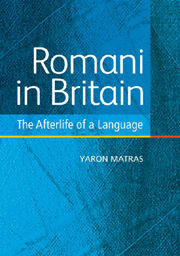Book contents
- Frontmatter
- Contents
- List of Figures, Tables and Maps
- List of Abbreviations
- Preface
- 1 Angloromani: A Different Kind of Language?
- 2 The Roots of Romani
- 3 The Historical Position of British Romani
- 4 The Structural Composition of Angloromani
- 5 The Conversational Functions of Angloromani
- 6 Conclusions: The Decline, Death and Afterlife of a Language
- Appendix I Lexicon of Angloromani
- Appendix II Predecessor expressions by origin
- References
- Author Index
- Subject Index
5 - The Conversational Functions of Angloromani
Published online by Cambridge University Press: 12 September 2012
- Frontmatter
- Contents
- List of Figures, Tables and Maps
- List of Abbreviations
- Preface
- 1 Angloromani: A Different Kind of Language?
- 2 The Roots of Romani
- 3 The Historical Position of British Romani
- 4 The Structural Composition of Angloromani
- 5 The Conversational Functions of Angloromani
- 6 Conclusions: The Decline, Death and Afterlife of a Language
- Appendix I Lexicon of Angloromani
- Appendix II Predecessor expressions by origin
- References
- Author Index
- Subject Index
Summary
Back to ‘languageness’
A central role in the formation process of mixed languages has been attributed by many writers to the conscious, emotional flagging of identity and group solidarity in small populations. Bakker (1997) regards mixed languages as an opportunity to flag ethnic admixture in populations of mixed households such as the Cree-French Michif (Métis) of Canada and in socially isolated peripatetic communities, while Golovko (2003) sees playful language mixing for the purpose of entertainment as a key tool in the formation of mixed ingroup codes such as Copper Island Aleut. Thomason (1995, 1999), too, makes some remarks in a somewhat similar direction, alluding to the role of speakers as conscious ‘engineers’ of language and proposing a connection with language-manipulation strategies that lead to the emergence of mixed idioms. More explicit is Vakhtin (1998), who identifies a conscious effort on the part of speakers to ‘resurrect’ a moribund language, resulting in the creation of a mixed code in the case of Copper Island Aleut. Taken for granted in most of these studies is the eventual stabilisation of ad hoc, stylistic mixing to form a coherent and consistent language system with a mixture of historical components. Mous (2003a, 2003b), for instance, acknowledges the role of lexical manipulation in the process that leads to the creation of Ma'a (the special, partly Cushitic lexicon used by the speakers of the Bantu language Mbugu in Tanzania) but emphasises that the ‘parallel lexicon’ that constitutes Ma'a is used as an all-purpose code and in some households even as the ‘unmarked’ option.
- Type
- Chapter
- Information
- Romani in BritainThe Afterlife of a Language, pp. 130 - 166Publisher: Edinburgh University PressPrint publication year: 2010



